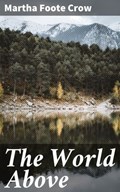In "The World Above," Martha Foote Crow crafts a compelling narrative that invites readers into the intricacies of human emotion and the interplay between nature and civilization. Set against a backdrop of the American wilderness, the book employs a lyrical prose style that reflects Crow's keen observation of the flora and fauna surrounding her. Through vivid imagery and a rich tapestry of sensory details, the text explores themes of solitude, wonder, and the quest for transcendence'Äîtying the human experience to the larger cycle of life. Crow's work sits comfortably within the tradition of early 20th-century American literature, echoing the transcendentalist movement while simultaneously grounding itself in realism. Martha Foote Crow was not only a pioneering writer but also an esteemed naturalist, which deeply informed her literary endeavors. Her background in education and affinity for nature allowed her to seamlessly blend scientific observation with poetic expression. Crow's encounters with various landscapes and her engagement with the philosophical undercurrents of her time inspired her to delve into the relationship between humanity and the natural world, which is poignantly portrayed in this work. "The World Above" is a must-read for those who seek to immerse themselves in poetic explorations of nature and self. It offers profound insights into the human spirit and its connection to the environment, making it an essential addition to the library of anyone interested in American literature, nature writing, or philosophical inquiry.

